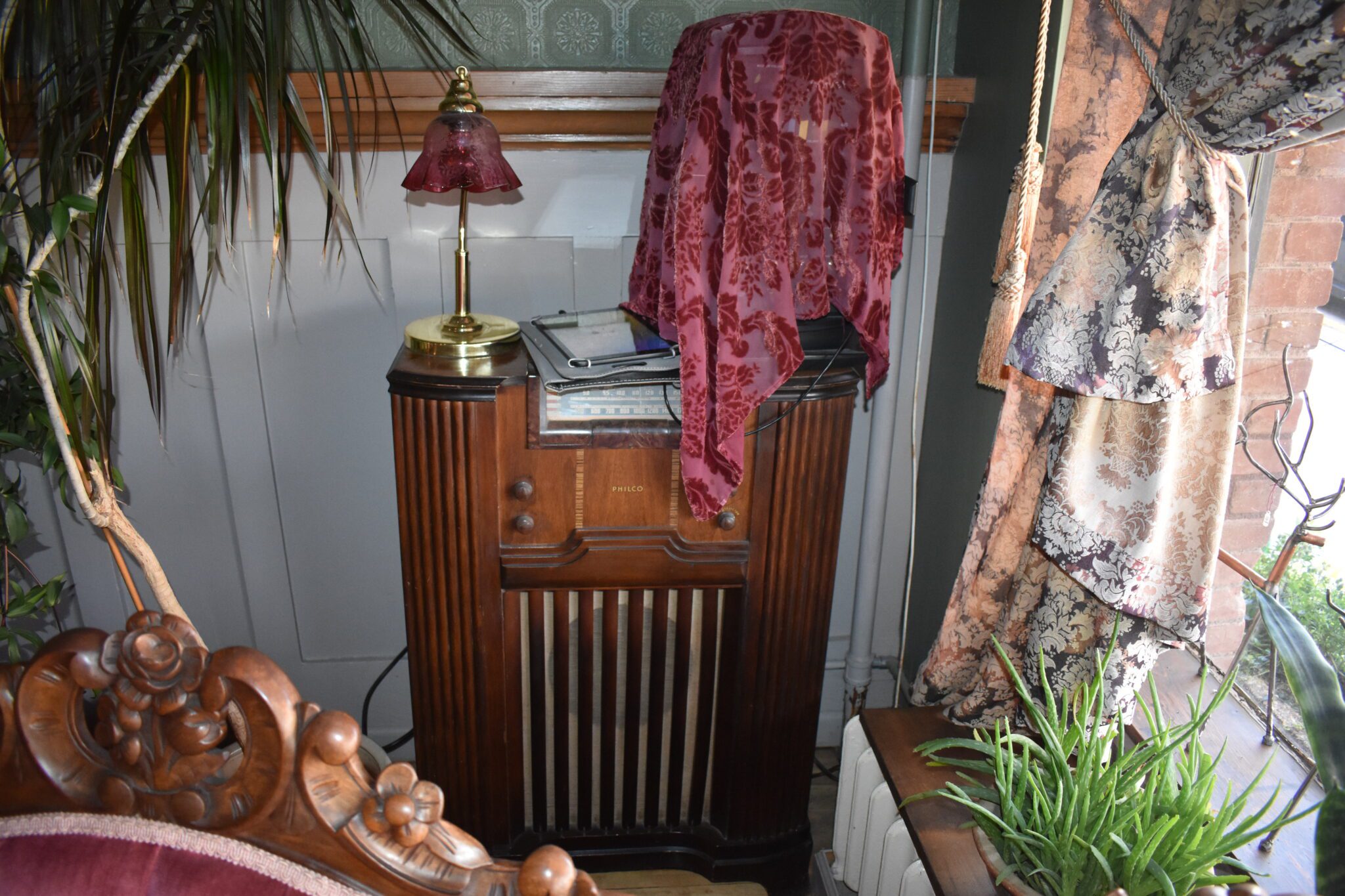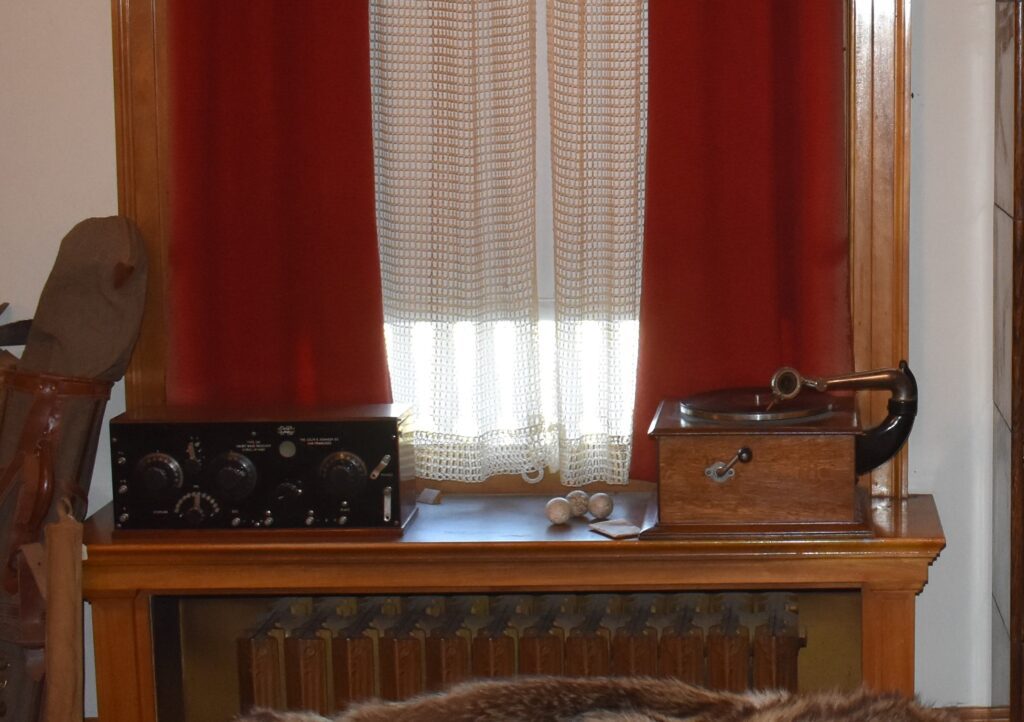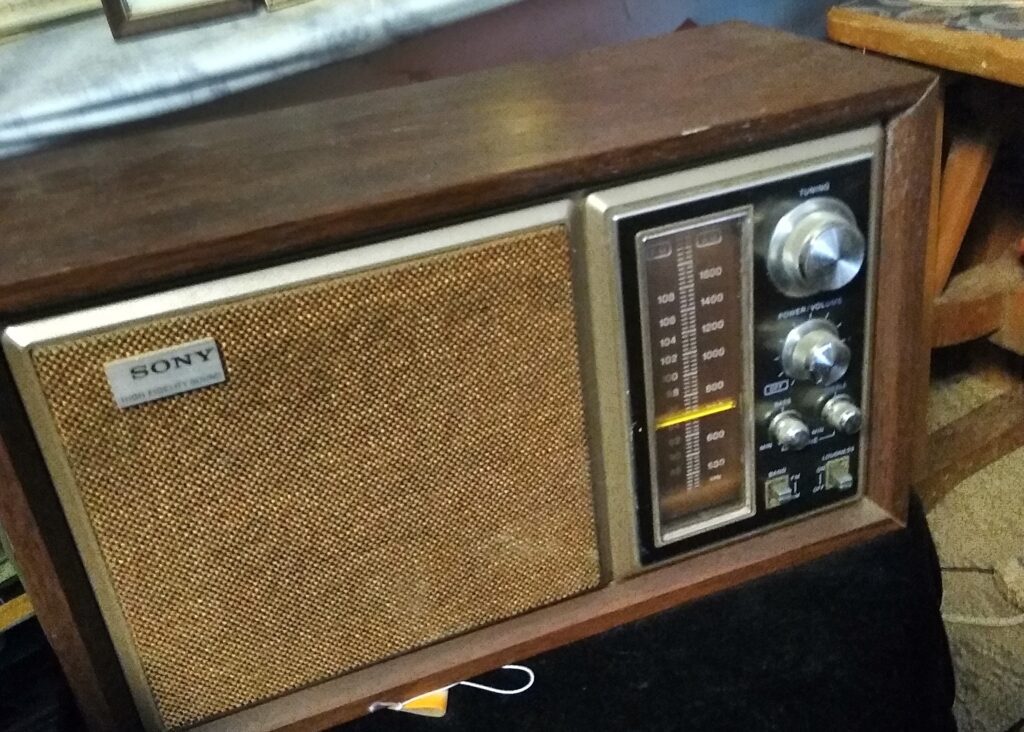News
History of Radio: Part Two

Photo: Old Radio on Display at Occidental Hotel in Buffalo
In the second part of this radio history column, we discover that although KWYO Radio first came on the air in 1934, radio, including KWYO, predated that by several years. Radios were at one time connected with telephone lines, but broadcasting over the air waves was certainly easier. As might be expected, politicians were quick to take advantage of the new technology.
This from the Uinta Chieftain, Evanston, on June 5, 1912 – State Radio Network Is Established McCoy to Speak at Opening Program June 10- The organization of a statewide radio hookup, linking Wyoming’s five radio stations for the first time, will be inaugurated at 7 p. m. June 10 in an address by Col. Tim McCoy motion picture star and rancher. Colonel McCoy, who is a candidate for the Republican nomination for the United States senate will outline his program and speak on the outstanding issues of the day in the address. This will be the first time that a political candidate’s address will have been broadcast simultaneously on all Wyoming radio stations. The statewide radio hookup was organized at the request of Colonel McCoy, and combines the facilities of KFBC at Cheyenne, KDFN at Casper, KVRS at Rock Springs, KPOW at Powell and KWYO at Sheridan.
The article went on to talk about how to obtain the hookup statewide.
Elaborate Preparations Are Necessary – Elaborate technical preparations were necessary. 687 miles of long-distance telephone lines are required for the hook-up. The program will be fed from KFBC studios in the Plains hotel, Cheyenne, directly to KVRS in Rock Springs and KDFN in Casper. The circuit will branch through repeaters at Casper and will be fed from there to KWYO in Sheridan and KPOW in Powell.
In the early days, it wasn’t always easy to run a radio station. Even today, sometimes technology fails, and the station is ‘off the air’ for a brief time. In August of 1934, the Lusk Freelance paper reported that a Durban, Natal radio station broadcast was halted for 11 minutes, after a moth flew into the rectifier panel, causing the fuses to melt. So, while sometimes blizzards or lightning strikes can cause a station to go down, even tiny insects can raise havoc with the radio broadcasts.
From The Riverton Review, April 26, 1922, there is a timeline of radio development. Last week’s column left off with the radio helping to save those who were aboard the Titanic when it sank in 1912.
And in 1913— Tests were made between the Eiffel tower in France and the station at Washington. During the trip into Central Asia an explorer received his longitude and time signals from a distant radio station. 1914 —Marconi and radio officials start test of wireless telephone between vessels of the Italian fleet. The test was continued between vessels on the high seas and voices were heard with clarity at a distance of 44 miles. One day radio telephone communication was kept up constantly for 12 hours. Great Britain declared war upon Germany August 4 and all private radio telegraphy and telephony suspended.
1915 — Radio communication between America and Japan is completed. The stations were located at San Francisco and Tokyo with a relay station at Honolulu. The American Telephone and Telegraph company succeeded in radio telephoning from Arlington station at Washington to Hawaii, a distance of nearly 5,000 miles. Secretary Daniels of the United States navy transmitted., telephonic messages from Washington to the Brooklyn navy yards.
1916— President Wilson and the mikado of Japan exchange messages over the new transpacific radio service, which is formally opened. 1917 — Senator Marconi visits the United States and aids greatly tn recruiting for radio operators for the United States army. 1918— Wireless telephony progressed rapidly, being used to a great extent In the equipment of airplanes. Several new long range stations were erected tn the United States, it being claimed for one built at Annapolis, MD.
1915 — Radio communication between America and Japan is completed. The stations were located at San Francisco and Tokyo with a relay station at Honolulu. The American Telephone and Telegraph company succeeded in radio telephoning from Arlington station at Washington to Hawaii, a distance of nearly 5,000 miles. Secretary Daniels of the United States navy transmitted., telephonic messages from Washington to the Brooklyn navy yards.
1916— President Wilson and the mikado of Japan exchange messages over the new transpacific radio service, which Is formally opened. 1917 — Senator Marconi visits the United States and aids greatly tn recruiting for radio operators for the United States army. 1918— Wireless telephony progressed rapidly, being used to a great extent In the equipment of airplanes
Several new long-range stations were erected in the United States, it being claimed for one built at Annapolis, Md, that it was capable of communication at 4000 miles. The US government also opened a high power station at Bordeaux.
In September of this year radio signals sent from a point 12000 miles away were received in Sydney, Australia.

1919,- with the exception of the three transatlantic flights, – that of the U.S. NC-4 and the British flights of Alcock and Brown and the dirigible R-34, in which radio communications played an important part in keeping the ships in the air and on their courses, no very great progress was made in radio telegraphy, although radio telephony was being pushed along quietly. Restrictions upon amateur receiving and sending were lifted by the American Government.
1920, this was the year of the radio telephone, more attention probably being paid to this branch of radio than to its older brother, telegraphy. Several broadcasting stations were opened. 1921 —This year was another radio telephonic year. It was marked by the opening of numerous broadcasting stations.
One use for the future of radio was reported in The Riverton Review, on July 4, 1923
Future Rural School May Operate by Radio – Prophets of Science Say Pupil, in Country Places May Even Hear College Lectures Broadcast—Farm Boy Could Go to School in His Own Home. – “Educated by radio!” That phrase will doubtless be spoken by people of future years when they refer to some public man or accomplished specialist of the day. The “radio college,” through which young folks of rural districts and boys and girls in scattered farmsteads can obtain a good all-round education, is under actual consideration by educational Institutions.
Several colleges have announced within the last year that they are seriously contemplating the establishment of radio courses, especially designed for students in the country districts. Within the last three months several Instances have been reported where college or high school Instructors hare given radio lectures of an educational nature.
As an everyday, permanent, well conducted department of American colleges, this is as yet only a shining possibility. Yet, if it proves as successful as it is expected to be, country young folk, who live far away from centers of learning, who could never get to high school, much less to college, will have high school and college almost literally brought to them. The limitations of the proven “little red schoolhouse” will truly be swept away.
The earnest, but often inexperienced and ill-paid, country schoolteacher will be reinforced, perhaps entirely supplanted, by the best type of college professor, through the wonder of the wireless…. The possibilities of radio for the farmer will undoubtedly make a receiving set virtually a necessity in the farmhouse. And think of the “radio college” that will be possible when, as a general practices, farmhouses are so equipped!
“Going to school” will then become an obsolete phrase to the farmer’s boy and girl. Instead, school will go to them, and they will get the essentials of a high school training, or the fundamentals of a college education, without leaving the home roof! Notwithstanding the impossibility of visual Instruction, or blackboard work, much will be possible of accomplishment. With the textbook in the pupil’s hands and the instructor’s voice telling him how to use the textbook, the mere machinery will be provided as successfully as In any classroom, and worthwhile results can follow.
Thorough Training Made Possible The pupil’s work, his examination papers, will perhaps be sent Into the school or college by mail at stated intervals. The instructor’s comments thereon will possibly come by radio in due time, a method will doubtless be devised for helping the backward pupils with special radio instruction The slow learners will be asked, it may be, to “stay after school.” in a new manner. The instructor will announce the names of such pupils at the beginning of an evening’s lecture, requesting them to continue listening in after the usual instruction period is over. The farther the pupil proceeds the better adapted radio may be found In education.
Lectures on college subjects, higher mathematics. science literature, agriculture, music, history, art, philosophy and many others, could certainly be very effectively broadcast by authorities. The farmer of twenty or thirty years from now may very likely stand on a complete Intellectual equality with the city businessman and the credit will belong entirely and utterly to radio.
The idea never caught on in America, as people began to move from the farms into the cities, transportation became easier for bringing rural children to school, and students continued to learn in ‘brick-and-mortar’ schools instead. However, in the vastness of Australia, this idea was put to good use in the outback beginning in 1951, youngsters learned by “School of the Air,” shortwave radio classes.

From the same article quoted above
Radio Broadcasting Valuable to Farmer By Maj. Gen. J. G. Harbord, President, Radio Corporation of America. The value of broadcasting to any individual or community will be in proportion to the difficulty of getting the same thing by any other means. Next to saving lives at sea, radio’s greatest service should be to the agricultural sections of this country.
It will serve the farmer and those who live in small communities no other utility has been able to serve him. It is already bringing him time signals, weather reports, market reports and agricultural information. Not until agricultural extension courses, religious services, opera, entertainment and education, which are now available in the cities, are regularly brought to the farmer by radio, will it have fulfilled its mission in American agriculture.
I am sure that radio cannot fail to bring all sections of our country closer together and improve its moral, social and economic stand arts.
Radio has done and continues to do all those things throughout the years. Even though children in American don’t do ‘School of the Air’ there are interesting talk shows, lectures, and other information.
Farmers still use radio for market reports, weather reports, and entertainment. Pickups, cars, tractors and off-road vehicles include or can have radios installed. There is local radio, satellite radio, as well as ham and shortwave radio, with something for every taste. So, tune into radio sometime, and remember that you are listening to a technology that has survived for over 100 years, growing and changing to meet current listeners demands.

